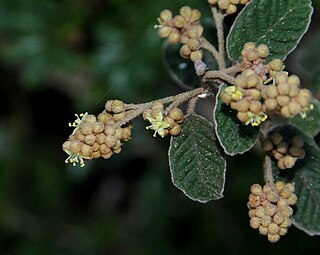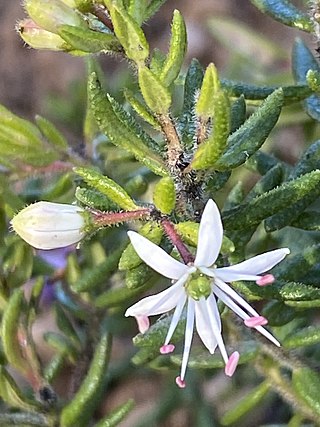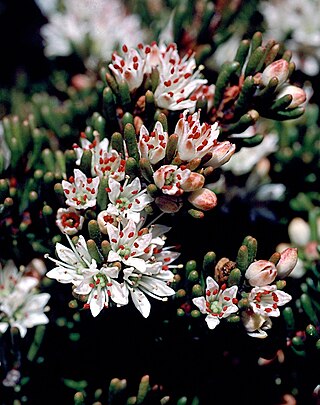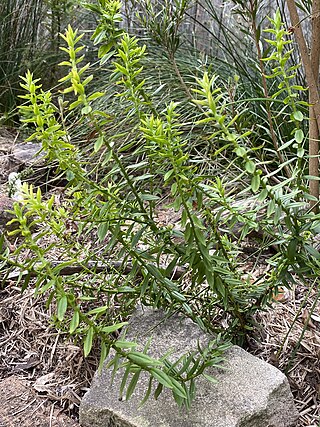
Hovea trisperma, commonly known as common hovea, it is a flowering plant in the family Fabaceae. It is a small straggling shrub with purple-blue flowers and is endemic to Western Australia.

Spyridium parvifolium, commonly known dusty miller, is a flowering plant in the family Rhamnaceae. It has dark green leaves and clusters of small, whitish flowers at the end of branches. It is widespread in eastern states of Australia.

Scaevola hookeri, commonly known as the creeping fan-flower or alpine fan-flower, is a species of flowering plant in the family Goodeniaceae. It has white or blue flowers with a yellow throat and grows in eastern Australia.

Pomaderris oraria, commonly known as Bassian dogwood, is a species of flowering plant in the family Rhamnaceae and is endemic to south-eastern Australia. It is a compact shrub with hairy branchlets, hairy, elliptic leaves and panicles of hairy, greenish to cream-coloured or crimson-tinged flowers.

Leionema carruthersii is a small shrub that is endemic to southern New South Wales in Australia. It has mostly greenish-yellow flowers, distinctive stamens and lance to egg-shaped leaves.
Leionema ceratogynum is a dense shrub, it grows on the south coast of New South Wales, Australia. It has oval-elliptic shaped leaves, scented foliage and lemon flowers usually in groups of three arising from the leaf axils.

Leionema diosmeum is a shrub species in the family Rutaceae that is endemic to southern New South Wales, Australia. It has an upright habit, stems with fine soft hairs, variable shaped leaves and yellow flowers from late winter to spring.

Leionema gracile, commonly known as Mt Greville phebalium, is a shrub species that is endemic to Queensland, Australia. It is a small shrub with spreading leaves, white petals and flowers from autumn to spring.
Leionema lachnaeoides, is a tall shrub with aromatic leaves and yellow flowers from winter to late spring. It is restricted to the Blue Mountains in New South Wales.

Leionema microphyllum, commonly known as limestone phebalium, is a small shrub with terminal clusters of white-pink flowers in spring. It is a rare plant in Victoria and South Australia.

Leionema montanum, is a small shrub with terminal clusters of white-pink flowers in upper leaf axils in spring. It is endemic to Tasmania.

Leionema praetermissum, is a shrub with warty stems covered in hairs, white flowers with spreading petals, and prominent stamens. It has a restricted distribution in New South Wales.

Olearia minor, is a small flowering shrub in the family Asteraceae. It has alternate leaves and white to pale mauve daisy-like flowers from winter to December. It grows in Western Australia, South Australia, New South Wales, and Victoria.

Hibbertia circinata is a species of flowering plant in the order Dilleniales and is endemic to eastern Australia. It is a tall, upright shrub with yellow flowers and broad, dark green leaves. It is a critically endangered species endemic to New South Wales.

Veronica continua is an upright, woody herb with blue flowers in dense clusters at the end of branches and leaves arranged in opposite pairs. It is endemic to Tasmania.

Spyridium burragorang, is a flowering shrub in the family Rhamnaceae. It has dense clusters of whitish flowers at the end of branches, alternate leaves and is endemic to New South Wales.

Pomaderris racemosa is a species of flowering plant in the family Rhamnaceae and is endemic to south-eastern Australia. It is a shrub or small tree with densely hairy branchlets, egg-shaped to broadly elliptic leaves, and racemes or panicles of cream-coloured flowers.
Scaevola spicigera is a species of flowering plant in the family Goodeniaceae. It is a small, spreading shrub with white flowers and is endemic to Western Australia.
Pomaderris subplicata, commonly known as concave pomaderris, is a species of flowering plant in the family Rhamnaceae and is endemic to Victoria in Australia. It is a shrub with softly-hairy branchlets, egg-shaped leaves, sometimes with the narrower end towards the base, and small clusters of pale yellow flowers.
Scaevola pulchella is a species of flowering plant in the family Goodeniaceae. It is a small, spreading shrub with blue to mauve flowers borne on terminal spikes and is endemic to Western Australia.















